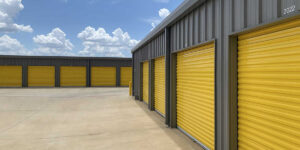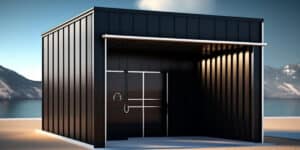Building Your Dream Garage: Understanding the Price Factors of a Shipping Container Conversion
Are you in need of a garage space that is both affordable and versatile? Look no further than a shipping container conversion! Shipping containers have gained popularity in recent years as a cost-effective and sustainable alternative for various purposes, including garage spaces.
Converting a shipping container into your dream garage may seem like a daunting task, but understanding the price factors involved can help you plan and budget effectively. In this section, we will delve into the key elements that affect the overall cost of a shipping container conversion.
Container Size and Condition
The size and condition of the shipping container you choose will significantly impact the price of your garage conversion. Standard containers come in various lengths, typically ranging from 20 to 40 feet. The larger the container, the higher the cost. Additionally, containers in better condition tend to be more expensive, as they require less repair work.
Structural Modifications
Structural modifications are necessary to transform a shipping container into a functional garage. These modifications include cutting doors and windows, reinforcing the container walls, and adding insulation for temperature control.
The complexity and extent of the structural modifications will affect the overall cost. Cutting and reinforcing the container walls can involve additional expenses, as you may need the services of a professional welder or metal fabricator. Insulation materials, such as spray foam or rigid panels, also contribute to the cost.
Electrical and Plumbing
If you plan to use your dream garage as a workshop or storage space, it’s essential to consider electrical and plumbing installations. Electrical work includes wiring, outlets, and lighting fixtures. Plumbing work, on the other hand, may involve installing sinks or drainage systems.
The complexity of the electrical and plumbing installations will determine the cost. If you have specific electrical or plumbing requirements, it is advisable to consult with professionals who specialize in container conversions to ensure safety and compliance with local building codes.
Flooring and Finishes
To create a comfortable and aesthetically pleasing garage space, you’ll need to consider the flooring and finishes. The type of flooring you choose, such as epoxy, vinyl, or tiles, will impact the cost. Additionally, adding finishes like drywall, paint, or cladding will contribute to the overall price.
Permits and Regulations
Before embarking on your shipping container conversion project, it is crucial to be aware of any permits and regulations required by your local authorities. These can include zoning permits, building permits, or HOA regulations.
Permit costs vary depending on your location and the complexity of the project. It is essential to research and factor in these costs to ensure a smooth and legal conversion process.
Additional Considerations
While the factors mentioned above are the primary cost contributors to a shipping container conversion, it’s important to consider other expenses that may arise during the project. These can include transportation costs to deliver the container to your location, professional fees for design consultations or project management, and the cost of any additional features you wish to include, such as ventilation systems or security measures.
By considering these additional factors and planning ahead, you can ensure a successful and cost-effective shipping container conversion for your dream garage.
In conclusion, understanding the price factors involved in a shipping container conversion is essential for budgeting and planning your dream garage. The size and condition of the container, structural modifications, electrical and plumbing installations, flooring and finishes, permits and regulations, as well as any additional considerations, all contribute to the overall cost. With careful planning and research, you can create a functional and stylish garage space without breaking the bank.
Shipping Container Garages: Is the Price Worth the Investment? A Cost-Benefit Analysis
Are you in need of extra storage space or a garage for your vehicles? Have you considered using shipping containers as a cost-effective solution? Shipping container garages have become increasingly popular in recent years due to their durability, versatility, and affordability. In this article, we will conduct a comprehensive cost-benefit analysis to determine whether the price of shipping container garages is worth the investment.
Cost Analysis
Initial Investment
When it comes to setting up a shipping container garage, the initial investment involves the purchase of the container itself. The price of a new shipping container can range from $2,000 to $5,000, depending on the size and condition. You can also find used containers at a lower cost, typically between $1,000 and $3,000. Keep in mind that additional expenses may arise for modifications, such as insulation, ventilation, and electrical wiring, depending on your specific needs.
Construction and Delivery
Once you have acquired a shipping container, you will need to consider the cost of delivery and installation. The price of delivery can vary depending on the distance and accessibility of your location. On average, you can expect to pay around $500 to $1,500 for delivery.
If you choose to modify the container yourself, you will need to factor in the cost of materials and equipment required for construction. Alternatively, hiring professionals to handle the modifications can increase the overall cost, but it ensures a higher quality and efficient outcome.
Maintenance and Upkeep
Shipping container garages are known for their durability and low maintenance requirements. However, some routine maintenance tasks are essential to ensure the longevity of your investment. These may include repainting the exterior to prevent rust, inspecting and repairing any leaks, and maintaining proper ventilation to prevent condensation build-up. The cost of maintenance can vary depending on the size of the container and the extent of modifications you have made.
Benefit Analysis
Versatility and Customization
One of the key benefits of shipping container garages is their versatility. These containers can be easily modified to suit your specific needs. Whether you require additional storage space, a workshop, or a garage for your vehicles, shipping containers can be customized to accommodate your requirements. With the ability to add windows, doors, insulation, and electrical wiring, you have the freedom to create a space that perfectly fits your needs.
Durability and Security
Shipping containers are designed to withstand harsh weather conditions and the rigors of international shipping. Made from strong steel, these containers offer excellent protection for your belongings and vehicles. They are resistant to fire, pests, and even vandalism. Additionally, shipping container garages offer enhanced security with the ability to install locks and security systems, ensuring the safety of your valuable possessions.
Cost Savings
Compared to traditional construction methods, shipping container garages offer significant cost savings. The initial purchase price of a shipping container is considerably lower than that of building a traditional garage. Additionally, the construction process is faster, saving you both time and money. Furthermore, the durability and low maintenance requirements of shipping containers translate into long-term cost savings as you won’t have to invest in frequent repairs or replacements.
Portability
Another advantage of shipping container garages is their portability. If you ever need to relocate or expand your storage space, you can easily transport the container to a new location. This flexibility makes shipping container garages a smart investment, especially for those who anticipate future changes in their storage or workspace needs.
Conclusion
After conducting a comprehensive cost-benefit analysis, it becomes evident that the price of shipping container garages is indeed worth the investment. The initial cost is significantly lower compared to traditional construction methods, and the durability, versatility, and security offered by shipping containers make them a practical choice for various purposes. Whether you need extra storage space, a workshop, or a garage, shipping container garages provide a cost-effective solution that can be customized to suit your needs. So, if you’re looking for an affordable and versatile option, investing in a shipping container garage is a wise decision.
From Storage to Stylish: Exploring the Price Range of Shipping Container Garages
When it comes to finding versatile and cost-effective storage solutions, shipping containers have become increasingly popular. Originally designed for transporting goods across the globe, these steel structures have found a new purpose as storage units, offices, homes, and even stylish garages. In this blog post, we will explore the price range of shipping container garages and how they can transform your space while keeping your budget in check.
The Basics of Shipping Container Garages
Shipping container garages offer a unique alternative to traditional brick-and-mortar structures. They are made from durable steel, which makes them resistant to extreme weather conditions and provides security for all your stored items. Furthermore, shipping containers can be easily modified to include windows, doors, insulation, and various other features to suit your specific needs.
Factors Affecting the Price Range
The cost of a shipping container garage can vary depending on several factors, including:
1. Size
The size of the shipping container you choose will impact the overall cost. Typically, containers come in standard sizes of 20 or 40 feet in length. However, you can also find containers in different sizes ranging from 10 to 45 feet. The larger the container, the higher the price will be.
2. Condition
The condition of the shipping container will also affect its price. New containers tend to be more expensive, while used containers are a more affordable option. However, it’s important to consider the condition carefully, as any necessary repairs or modifications may add to the overall cost.
3. Customization
The level of customization you desire will impact the price of your shipping container garage. Basic modifications, such as adding a door or window, are relatively inexpensive. However, if you wish to include insulation, electrical wiring, plumbing, or other advanced features, the cost will increase accordingly.
4. Delivery and Installation
Shipping containers are heavy and require specialized equipment for transportation and installation. The distance of delivery and the complexity of installation will affect the overall cost. Additionally, if you plan to stack multiple containers or create a multi-level structure, additional costs may be incurred.
Price Range Examples
While the price range of shipping container garages can vary significantly depending on the factors mentioned above, here are a few examples to give you an idea of what to expect:
- A standard 20-foot used container without any modifications can range from $2,000 to $4,000.
- Adding basic modifications, such as windows and doors, can increase the price by around $500 to $1,000.
- For larger containers or more extensive customization, prices can range from $5,000 to $10,000 or more.
- Delivery and installation costs typically range from $500 to $2,000, depending on the distance and complexity.
Keep in mind that these prices are approximate and can vary based on your location, the vendor, and the specific requirements of your project. It’s always recommended to obtain multiple quotes and consult with professionals before making a decision.
Benefits of Shipping Container Garages
Apart from their affordability, shipping container garages offer several advantages:
1. Durability
Shipping containers are built to withstand the rigors of international transportation, making them highly durable. They can withstand extreme weather conditions and provide long-lasting protection for your stored items.
2. Versatility
Shipping containers can be easily modified to suit your specific needs. Whether you need additional storage space, a workshop, or a stylish garage, these structures can be customized accordingly. Their modular nature allows for easy expansion or relocation if necessary.
3. Eco-Friendly
Repurposing shipping containers helps reduce waste and promotes sustainability. By giving these steel structures a second life as garages, you contribute to the recycling movement and minimize the environmental impact of traditional construction.
Conclusion
Shipping container garages offer an affordable and versatile solution for those in need of additional storage or stylish garage space. While the price range can vary depending on factors such as size, condition, customization, and delivery, these structures provide durability, versatility, and eco-friendliness. Before diving into a shipping container garage project, research local vendors, obtain multiple quotes, and consult with professionals to ensure the best outcome for your budget and needs.
Budgeting for a Shipping Container Garage: How Much Does it Really Cost?
If you’re considering building a garage and want something unique and durable, a shipping container garage might be the perfect solution. Shipping containers are not only cost-effective but also offer a versatile and modern aesthetic. However, before you dive into this project, it’s crucial to understand the costs involved to ensure it fits within your budget. In this section, we will break down the various expenses associated with building a shipping container garage.
The Container
The first and most significant expense when building a shipping container garage is, of course, the container itself. The cost of a shipping container can vary depending on several factors, such as size, condition, and location. On average, a used shipping container can cost anywhere between $1,500 to $5,000. If you prefer a new container or one in excellent condition, the price can go up to $6,000 or more. It’s essential to consider your budget and purpose when deciding on the container’s condition.
Site Preparation
Before placing the container, you’ll need to prepare the site. This typically involves clearing the area, leveling the ground, and possibly pouring a concrete foundation. The cost of site preparation can vary based on the complexity of the work and your location. On average, you can expect to spend around $1,000 to $5,000 for site preparation, including leveling and foundation costs.
Delivery and Placement
Shipping containers are large and heavy, which means you’ll need to hire a professional delivery service to transport and place it on your property. The cost of delivery varies depending on the distance, accessibility of your property, and the size of the container. On average, you can expect to pay between $500 to $1,500 for delivery and placement.
Insulation and Ventilation
To make your shipping container garage comfortable and functional, you’ll need to insulate and ventilate it properly. Insulation helps regulate temperature, prevents condensation, and reduces noise. Ventilation ensures proper air circulation and prevents moisture buildup. The cost of insulation and ventilation materials, such as spray foam, insulation panels, and vents, can range from $500 to $2,000, depending on the size of your container.
Electrical and Plumbing
If you plan to use your shipping container garage as a workshop or storage space, you may need to consider electrical and plumbing installations. This includes wiring for lighting, outlets, and potentially running water for sinks or toilets. The cost of electrical and plumbing work will vary based on your specific needs and local labor rates. On average, you can expect to spend around $1,000 to $5,000 for these installations.
Interior Finishes
Once the necessary infrastructure is in place, you’ll want to consider the interior finishes to make your shipping container garage feel like a functional space. This can include drywall, flooring, paint, shelving, and any additional customizations you desire. The cost of interior finishes depends on your preferences and the size of the container but can range from $1,000 to $5,000 or more.
Permits and Regulations
Before embarking on your shipping container garage project, it’s crucial to check with your local authorities regarding permits and regulations. Depending on your location, you may require permits for site preparation, delivery, and any modifications made to the container. The cost of permits varies by region but can range from $100 to $1,000.
Miscellaneous Costs
Finally, it’s important to account for miscellaneous costs that may arise during the construction process. These can include tools, equipment rentals, professional services, and unforeseen expenses. It’s advisable to set aside about 10% to 15% of your total budget for such costs.
Conclusion
Building a shipping container garage can be an exciting and cost-effective project, but it’s essential to budget wisely to avoid any surprises along the way. By considering the costs of the container, site preparation, delivery, insulation, electrical and plumbing, interior finishes, permits, and miscellaneous expenses, you can estimate the total cost and ensure your project fits within your budget. Remember to research local suppliers, contractors, and regulations to make the most informed decisions. With proper planning and budgeting, you’ll be on your way to enjoying the convenience and uniqueness of a shipping container garage.
Unlocking the Cost of Building a Shipping Container Garage: A Comprehensive Price Guide
Are you in need of extra space for storage, a workshop, or a unique living space? Look no further than a shipping container garage. These versatile structures have gained popularity in recent years due to their durability, affordability, and eco-friendly nature. However, one question that often arises is, “How much does it cost to build a shipping container garage?” In this comprehensive price guide, we will unlock the cost of building a shipping container garage, providing you with valuable insights and tips to help you plan your project effectively.
Factors Affecting the Cost
Several factors influence the cost of building a shipping container garage. Understanding these factors will allow you to make informed decisions and budget accordingly. Here are the key factors to consider:
1. Size of the Garage
The size of the shipping container garage is one of the most significant cost determinants. The larger the structure, the more materials and labor will be required, resulting in higher costs. Consider the intended use of the garage and determine the size that suits your needs while staying within your budget.
2. Condition of the Container
The condition of the shipping container is an important factor to consider. Brand new containers will generally cost more than used ones, but they offer the advantage of being in top condition. Used containers, on the other hand, may require some repairs or modifications, which can add to the overall cost.
3. Site Preparation
Before you can start building your shipping container garage, you’ll need to prepare the site. This includes leveling the ground, clearing debris, and ensuring proper drainage. Site preparation costs can vary depending on the condition of the land and the amount of work required.
4. Foundation
The type of foundation you choose for your shipping container garage will impact the overall cost. Common options include concrete slabs, piers, or a combination of both. Each foundation type has its own pros and cons, so consider your local climate and soil conditions when making your decision.
5. Insulation and Climate Control
If you plan on using your shipping container garage for more than just storage, you’ll need to insulate and climate control the space. Insulation helps regulate temperature, while climate control ensures comfortable conditions year-round. These additions will increase the upfront cost but can save you money in the long run by reducing energy consumption.
6. Exterior Finishes and Modifications
Shipping container garages offer numerous customization options. From windows and doors to additional entry points and exterior finishes, the choices are endless. Keep in mind that each modification will add to the overall cost, so prioritize your needs and budget accordingly.
Average Cost Breakdown
Now that we’ve discussed the key factors influencing the cost, let’s take a closer look at the average cost breakdown of building a shipping container garage:
-
Container Cost: On average, a used shipping container can cost anywhere from $2,000 to $5,000, while new containers can cost between $4,000 and $7,000 depending on the size and condition.
-
Site Preparation: Site preparation costs can range from $500 to $2,500 or more, depending on the complexity of the terrain and required work.
-
Foundation: The cost of the foundation will vary depending on the type chosen. A concrete slab foundation can cost between $4,000 and $8,000, while pier foundations range from $1,000 to $5,000.
-
Insulation and Climate Control: Insulation and climate control costs will depend on the size of the space and the desired level of comfort. On average, expect to spend between $1,500 and $5,000 for insulation and between $1,000 and $4,000 for climate control.
-
Exterior Finishes and Modifications: The cost of exterior finishes and modifications can vary widely. Adding windows and doors can cost between $500 and $2,000 each, while custom finishes can range from $2,000 to $10,000 or more.
-
Labor Costs: Labor costs will depend on the complexity of the project and the local labor rates. However, as a rough estimate, labor costs for building a shipping container garage can range from $5,000 to $15,000.
It’s important to remember that these cost estimates are averages, and prices can vary significantly depending on factors such as location, materials used, and customization choices.
Tips for Cost-Effective Construction
If you’re looking to build a shipping container garage on a budget, here are a few tips to help you keep costs in check:
-
Consider used containers: Used containers can be a cost-effective option, but ensure they are in good condition and require minimal repairs.
-
Optimize the size: Determine the minimum size required for your needs to avoid unnecessary expenses.
-
Do it yourself: If you have the skills and time, consider taking on some of the construction work yourself to save on labor costs.
-
Prioritize essential modifications: Focus on essential modifications first and consider adding more over time as your budget allows.
-
Source materials locally: Buying materials locally can help save on transportation costs.
-
Get multiple quotes: Obtain quotes from different contractors and suppliers to ensure you’re getting the best price for the services and materials required.
By following these tips and planning your project carefully, you can build a shipping container garage that meets your needs without breaking the bank.
Conclusion
Building a shipping container garage can be an exciting and cost-effective way to add extra space to your property. By understanding the factors that influence costs and following the tips provided, you can embark on your project with confidence. Remember to plan ahead, set a realistic budget, and consult with professionals to ensure a successful and budget-friendly construction process. Happy building!




